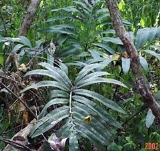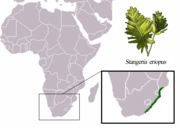
Stangeria
Encyclopedia
Stangeria eriopus is a cycad
endemic to southern Africa
It is the sole species in the genus Stangeria, most closely related to the Australia
n genus Bowenia
, with which it forms the family Stangeriaceae
.
Stangeria eriopus has pinnately-veined, fern-like leaves
that distinguish it from all other cycads. The species occurs as two variable forms or varieties. The forest form, growing in regions with higher rainfall, is characterized by large, wide leaves that can reach up to 2 m in length. The grassland
form, growing in regions subject to annual fire and drought, has shorter leaves with a thicker cuticle that may only be 30 cm long. In both varieties the petiole
comprises one third to one half of the overall leaf length.
Stems are completely subterranean and the root is shaped like a carrot
. As in other cycads, S. eriopus forms coralloid roots. These are specialized, plagiotropic (sideways-growing) roots housing colonies of cyanobacteria that fix nitrogen, much like the roots of legumes.
S. eriopus reaches maturity at 5–7 years of age, and has stalked cones
as reproductive organs. As is typical of cycads, the species is dioecious, meaning that male and female cones are borne on different plants. The cones are insect-pollinated, giving off a faint odor to attract beetle pollinators. At maturity they fall apart to reveal the seeds, which are 2-3 cm in length.
The binomial name comes from the Greek
prefix erio-, meaning "woolly", and suffix -pus, "footed", referring to the woolly petiole bases.
 It is native to the east coast of South Africa
It is native to the east coast of South Africa
and southern Mozambique
. It is found within 50 km, but not closer than 2 to 3 km, from the sea. This species of cycad is adaptable and is found in many habitats, from closed forest to grassland, but it is under increasing threat from habitat loss and unsustainable harvesting for traditional medicinal purposes.
Cycad
Cycads are seed plants typically characterized by a stout and woody trunk with a crown of large, hard and stiff, evergreen leaves. They usually have pinnate leaves. The individual plants are either all male or all female . Cycads vary in size from having a trunk that is only a few centimeters...
endemic to southern Africa
Africa
Africa is the world's second largest and second most populous continent, after Asia. At about 30.2 million km² including adjacent islands, it covers 6% of the Earth's total surface area and 20.4% of the total land area...
It is the sole species in the genus Stangeria, most closely related to the Australia
Australia
Australia , officially the Commonwealth of Australia, is a country in the Southern Hemisphere comprising the mainland of the Australian continent, the island of Tasmania, and numerous smaller islands in the Indian and Pacific Oceans. It is the world's sixth-largest country by total area...
n genus Bowenia
Bowenia
The genus Bowenia, includes two living and two fossil species of cycads in the family Stangeriaceae, sometimes placed on their own family Boweniaceae. They are entirely restricted to Australia...
, with which it forms the family Stangeriaceae
Stangeriaceae
Stangeriaceae is the smallest family of cycads, both in number of living and fossil species. The family contains only two living genera, Stangeria and Bowenia, though the latter genus has been recommended for placement in a separate family by itself....
.
Stangeria eriopus has pinnately-veined, fern-like leaves
Leaf
A leaf is an organ of a vascular plant, as defined in botanical terms, and in particular in plant morphology. Foliage is a mass noun that refers to leaves as a feature of plants....
that distinguish it from all other cycads. The species occurs as two variable forms or varieties. The forest form, growing in regions with higher rainfall, is characterized by large, wide leaves that can reach up to 2 m in length. The grassland
Grassland
Grasslands are areas where the vegetation is dominated by grasses and other herbaceous plants . However, sedge and rush families can also be found. Grasslands occur naturally on all continents except Antarctica...
form, growing in regions subject to annual fire and drought, has shorter leaves with a thicker cuticle that may only be 30 cm long. In both varieties the petiole
Petiole (botany)
In botany, the petiole is the stalk attaching the leaf blade to the stem. The petiole usually has the same internal structure as the stem. Outgrowths appearing on each side of the petiole are called stipules. Leaves lacking a petiole are called sessile, or clasping when they partly surround the...
comprises one third to one half of the overall leaf length.
Stems are completely subterranean and the root is shaped like a carrot
Carrot
The carrot is a root vegetable, usually orange in colour, though purple, red, white, and yellow varieties exist. It has a crisp texture when fresh...
. As in other cycads, S. eriopus forms coralloid roots. These are specialized, plagiotropic (sideways-growing) roots housing colonies of cyanobacteria that fix nitrogen, much like the roots of legumes.
S. eriopus reaches maturity at 5–7 years of age, and has stalked cones
Conifer cone
A cone is an organ on plants in the division Pinophyta that contains the reproductive structures. The familiar woody cone is the female cone, which produces seeds. The male cones, which produce pollen, are usually herbaceous and much less conspicuous even at full maturity...
as reproductive organs. As is typical of cycads, the species is dioecious, meaning that male and female cones are borne on different plants. The cones are insect-pollinated, giving off a faint odor to attract beetle pollinators. At maturity they fall apart to reveal the seeds, which are 2-3 cm in length.
The binomial name comes from the Greek
Greek language
Greek is an independent branch of the Indo-European family of languages. Native to the southern Balkans, it has the longest documented history of any Indo-European language, spanning 34 centuries of written records. Its writing system has been the Greek alphabet for the majority of its history;...
prefix erio-, meaning "woolly", and suffix -pus, "footed", referring to the woolly petiole bases.
Distribution

South Africa
The Republic of South Africa is a country in southern Africa. Located at the southern tip of Africa, it is divided into nine provinces, with of coastline on the Atlantic and Indian oceans...
and southern Mozambique
Mozambique
Mozambique, officially the Republic of Mozambique , is a country in southeastern Africa bordered by the Indian Ocean to the east, Tanzania to the north, Malawi and Zambia to the northwest, Zimbabwe to the west and Swaziland and South Africa to the southwest...
. It is found within 50 km, but not closer than 2 to 3 km, from the sea. This species of cycad is adaptable and is found in many habitats, from closed forest to grassland, but it is under increasing threat from habitat loss and unsustainable harvesting for traditional medicinal purposes.

